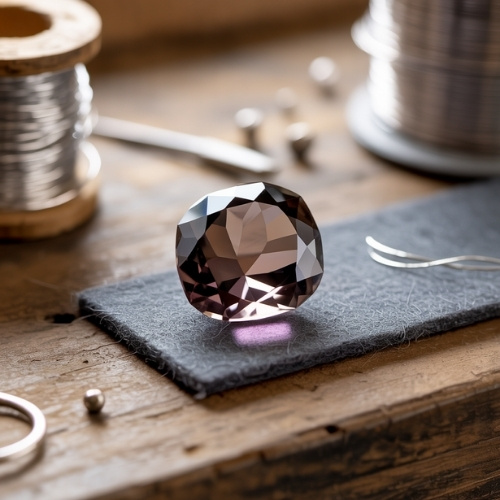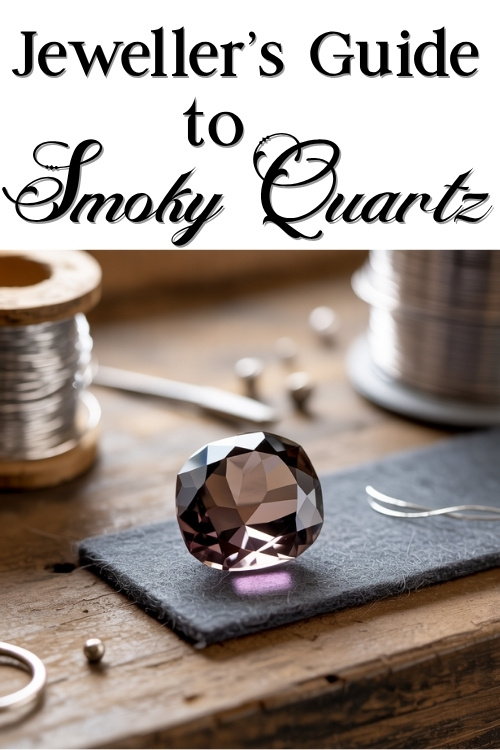With its rich, earthy tones ranging from soft, translucent greys to deep, velvety browns, smoky quartz is a favourite among jewellers and collectors alike. As one of the most versatile and affordable quartz varieties, it lends itself beautifully to everything from minimalist designs to bold statement pieces.
Basic Identification Information
Name & Synonyms
Smoky Quartz
Also known as Cairngorm (from Scotland) or Morion (for very dark specimens)
Species
Quartz
Colour Range
Brown, Black, Grey
Refractive Index
1.544–1.553
Birefringence
0.009
Optical Sign
Uniaxial +
Pleochroism
Weak and 2 colours
Dark stones: brown and reddish brown
Light stones: 2 shades of yellowish brown
Specific Gravity
2.65
Fluorescence
None
Lustre
Vitreous (glass-like)
Clarity (GIA Type 1)
Type I
Usually eye-clean
Gems Often Mistaken For
Topaz, Tourmaline (dravite), Obsidian
Mohs Hardness
7
Wearability
Excellent — suitable for daily wear
Birthstone
Alternative birthstone for November
Spotting Synthetic (Lab-Grown) Smoky Quartz
Synthetic smoky quartz can be produced in a lab using hydrothermal methods, but in practical terms, it’s virtually non-existent in the jewellery trade. Natural smoky quartz is abundant, affordable, and readily available in clean crystals, making synthetic production commercially unnecessary. In the rare event that a lab-grown specimen does appear, it may look unusually flawless or evenly coloured, but proper identification typically requires advanced gemological testing.
Common Treatments
Smoky quartz is often heat-treated, and this enhancement plays a subtle but important role in the gem’s appearance. Naturally, many smoky quartz crystals are quite pale, showing only a hint of their characteristic brown-grey hue. Heating can intensify these tones, resulting in deeper, more even colours that are especially desirable for jewellery use.
In some cases, heat treatment is used to transform smoky quartz into citrine. While they belong to the same mineral family, citrine typically commands higher prices in the market, and this conversion allows otherwise low-value material to be reclassified and sold at a higher price point.
These treatments are generally stable and widely accepted within the industry. However, they leave no visible signs, making them difficult to detect.
Durability & Setting Considerations
Smoky quartz is a reliable and robust choice for a wide range of jewellery applications. With a Mohs hardness of 7, it holds up well to daily wear and resists surface scratching from common abrasives like household dust. While it’s not as hard as sapphire or diamond, it’s still tough enough for rings, bracelet, and other exposed settings.
That said, like many quartz varieties, smoky quartz can be sensitive to thermal shock. Sudden temperature changes, particularly extreme heat followed by rapid cooling, may cause internal fractures or breakage. This is especially important for jewellers working at the bench. Casting in place is not recommended, as the heat involved in the process poses a high risk of cracking the stone.
From a setting perspective, smoky quartz is a forgiving material to work with. Bezel settings are particularly well-suited, offering both physical protection and a way to frame the stone’s warm, smoky glow. Prong settings are also effective, especially for faceted pieces, though care should be taken to avoid excessive pressure at the corners during setting.
Care Instructions
Cleaning
Clean smoky quartz with warm, soapy water and a soft brush.
Ultrasonic cleaners are usually safe, but avoid steam cleaning.
Storage
Store separately from harder gemstones to prevent scratches. Wrap in a soft cloth or place in a padded compartment.
Daily Wear
Its durability makes it a low-maintenance choice for rings, pendants, and bracelets. However, take care to protect against sudden impacts or high heat.
Market & Ethical Notes
Smoky quartz is mined in many regions around the world, with major sources including Brazil, Madagascar, the USA (notably Colorado), and Scotland’s Cairngorm Mountains.
It’s a plentiful, affordable gemstone that’s ideal for accessible, large-scale designs as well as high-end artistic pieces.
From an ethical standpoint, smoky quartz is considered a relatively low-impact gem. It often forms in pegmatite or granite environments and is frequently a byproduct of mining for other minerals, reducing overall waste.
Symbolic & Spiritual Meanings
Smoky quartz has long been connected to protection, strength, and grounding. In ancient Scotland, warriors carried smoky quartz into battle, believing it would grant endurance and courage. Druids revered it for its spiritual connection and ability to anchor the soul.
Today, it’s still celebrated in crystal healing circles as a powerful stone for emotional balance. It’s also commonly linked to the root chakra, supporting stability, presence, and resilience.
🔗 Dive deeper into Smoky Quartz’s Symbolic & Spiritual Meanings
Etymology
The name smoky quartz comes from its signature misty tones, like smoke captured in stone.
Darker specimens are sometimes referred to as morion, a word of debated origin. It may derive from Latin morio (meaning fool or dark) or from the German term morion, used in medieval lapidary texts to describe dark quartz.
🔗Curious about how smoky quartz was viewed in ancient cultures? Explore its fascinating myths and legends (coming soon)
📌 Save this jeweller’s guide to smoky quartz for quick reference next time you’re working with this stunning gem.


